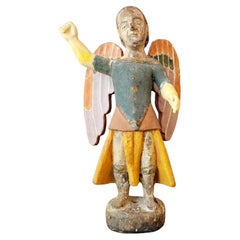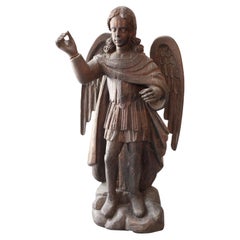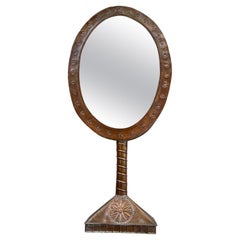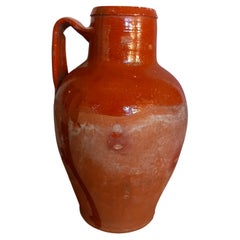Spanish Colonial Folk Art
After the conquest of Mexico in 1521 and the Philippines in 1565, Spain dictated a global culture. The colonization of territories in the Americas, Western Europe, Africa, Oceania and the Pacific imposed the values of Spain, including Catholicism, while the extraction of resources reinforced the empire’s wealth and power. Unlike many styles that came out of European colonialism, such as British Colonial, Spanish Colonial furniture and architecture frequently mixed local heritage with the artistic traditions of Spain.
Spanish Colonial furniture was informed by the shifting styles of Europe as well as Indigenous culture. There were Inca tapestries depicting Spanish coats of arms and Baroque chairs adorned with tropical flora. The butaca, a low easy chair popular in the Caribbean, was inspired by Rococo’s curving forms and the shape of precolonial seating. In New Mexico, Pueblo artisans carved chests with patterns reminiscent of Anasazi art.
Even within the homes of the wealthy, furniture was usually restricted to necessities like benches, desks, cupboards and chests. These were often ornately designed and especially important for storing prized goods like textiles. Spanish Colonial houses were built with adobe and clay and tended to be minimally decorated, so the style’s heavily carved wooden furniture pieces stood out against a home’s white stucco walls.
The Spanish Colonial period mostly came to an end after the territories achieved independence from Spain. However, its aesthetics continued to influence Southwestern style and Spanish Colonial Revival style after Spanish Colonial style was used extensively at San Diego’s 1915 Panama-California Exposition.
Find a collection of antique Spanish Colonial chairs, tables, bedroom furniture and other furniture on 1stDibs.
1950s Spanish Vintage Spanish Colonial Folk Art
Wood, Paper
19th Century Philippine Antique Spanish Colonial Folk Art
Glass, Wood, Paper
Early 19th Century North American Antique Spanish Colonial Folk Art
Wood, Paint
18th Century Guatemalan Antique Spanish Colonial Folk Art
Wood
1960s Mexican Vintage Spanish Colonial Folk Art
Copper
Early 20th Century European Spanish Colonial Folk Art
Clay
Late 18th Century Antique Spanish Colonial Folk Art
Gesso, Wood, Paint
21st Century and Contemporary Mexican Spanish Colonial Folk Art
Ceramic, Clay, Majolica
21st Century and Contemporary Mexican Spanish Colonial Folk Art
Ceramic, Clay, Majolica
18th Century Italian Antique Spanish Colonial Folk Art
Giltwood
21st Century and Contemporary Mexican Spanish Colonial Folk Art
Ceramic, Clay, Majolica
21st Century and Contemporary Mexican Spanish Colonial Folk Art
Ceramic, Clay, Majolica
Mid-18th Century Peruvian Antique Spanish Colonial Folk Art
Canvas, Wood, Paint
21st Century and Contemporary Mexican Spanish Colonial Folk Art
Ceramic, Majolica, Clay
17th Century Spanish Antique Spanish Colonial Folk Art
Wood
21st Century and Contemporary Mexican Spanish Colonial Folk Art
Ceramic, Clay, Majolica
Late 20th Century Mexican Spanish Colonial Folk Art
Terracotta
Late 20th Century Mexican Spanish Colonial Folk Art
Wool, Cotton
21st Century and Contemporary Mexican Spanish Colonial Folk Art
Ceramic, Clay, Majolica
21st Century and Contemporary Mexican Spanish Colonial Folk Art
Ceramic, Majolica, Clay
Early 19th Century Chilean Antique Spanish Colonial Folk Art
Wrought Iron
Late 19th Century American Antique Spanish Colonial Folk Art
Wool, Cotton
Mid-20th Century Spanish Spanish Colonial Folk Art
Ceramic, Clay
Early 19th Century Chilean Antique Spanish Colonial Folk Art
Wood
Late 18th Century Antique Spanish Colonial Folk Art
Wood
Late 19th Century Central American Antique Spanish Colonial Folk Art
Wood
Late 18th Century Mexican Antique Spanish Colonial Folk Art
Gold Leaf
21st Century and Contemporary Mexican Spanish Colonial Folk Art
Clay, Ceramic, Majolica
Mid-20th Century Guatemalan Spanish Colonial Folk Art
Wool
Late 19th Century Mexican Antique Spanish Colonial Folk Art
Wood
19th Century South American Antique Spanish Colonial Folk Art
Gesso, Wood
Late 19th Century Central American Antique Spanish Colonial Folk Art
Gesso, Wood
19th Century Mexican Antique Spanish Colonial Folk Art
Tin
19th Century Peruvian Antique Spanish Colonial Folk Art
Cowhide, Leather
17th Century North American Antique Spanish Colonial Folk Art
Canvas
Mid-18th Century North American Antique Spanish Colonial Folk Art
Copper
1880s North American Antique Spanish Colonial Folk Art
Canvas
Early 20th Century Spanish Spanish Colonial Folk Art
Ceramic
Early 20th Century Spanish Spanish Colonial Folk Art
Ceramic
Late 17th Century Spanish Antique Spanish Colonial Folk Art
Wood



